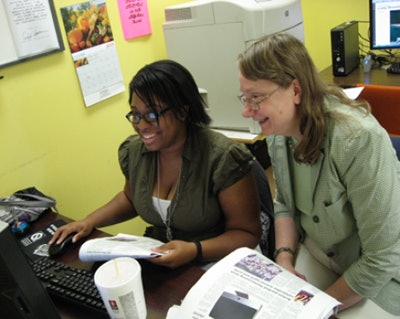Marlo was hurrying to Old Main, the oldest building on the University of North Carolina at Pembroke campus that houses the student newspaper office. What he spotted hanging in a tree stopped him cold. He was aware of the then-recent controversies of nooses hanging in trees on campuses in the South. Stopping for a closer look, he saw a larger than man-sized metal canvas, etched with a rusty outline of a man, suspended from a branch, gently swaying in the breeze.
 Dr. Judith G. Curtis, right, has served as faculty adviser to the University of North Carolina at Pembroke newspaper for more than a decade.
Dr. Judith G. Curtis, right, has served as faculty adviser to the University of North Carolina at Pembroke newspaper for more than a decade.The university, consistently ranked one of the most diverse in the Southeast, was the first higher education institution for Native Americans in the nation. The student body includes a healthy mix of Native American, African-American, Caucasian, Hispanic, Asian American, and international students. An African-American, Marlo couldn’t recall any racial incidents on campus.
His investigative story into the hanging revealed it was an international student’s senior art project that conveyed her vision of universal man in a struggle with the elements. His series of articles started a conversation that led to student forums; interdisciplinary discussions about intellectual freedom, perception, and the meaning of art; and an extraordinary dialogue among students, faculty, administrators, trustees, and the community. The coverage defused a potentially polarizing and confrontational occurrence and turned it into a discussion on race that built trust and understanding.
The newspaper proactively covers issues dealing with diversity that still challenge professional newsrooms today. Since the 1960s, the Kerner Report, and others, has urged media organizations to diversify newsrooms and expand their definition of news to include multiculturalism. One goal at the end of the 1970s called for diversity in newsrooms to be on par with the minority population by 2000. That goal was not met. A new goal aims for 2025.
In another example, Nick, the editor-in-chief, spotted a group of young women crossing the railroad tracks at the edge of campus on their way to McDonald’s. One student waved her hand and veered left in her wheelchair. She traveled a quarter-mile through a parking lot paralleling the tracks, turned right onto the berm of a four-lane highway to wheel across the tracks, then right again to parallel the tracks on yet another highway before dodging traffic to catch up with her friends. There was no accessible crossing over the tracks that separated the campus from town. While her friends gingerly picked their way across a ditch, up a bank, then across the tracks, as if competing on an obstacle course, her chair’s wheels would never have made it across without being stuck.
Nick was sympathetic, having started as a reporter under an earlier editor-in-chief who also happened to use a wheelchair. In digging out the story, he talked to university officials, Pembroke town officials, the North Carolina Department of Transportation, and CSX railroad officials. Everyone placed responsibility elsewhere, creating a whirlwind of finger pointing and denials. The published front-page story included a photo of the student in her wheelchair competing with cars and truck traffic to get to a smooth patch to cross the tracks. Fewer than two months later, the agencies worked together to install an accessible crossing that improved everyone’s safety.
In another groundbreaking story, Skyler, an African-American female staff reporter, gained the trust of a number of young women, some single mothers with children to support and often first-generation college students, who agreed to be sources for an investigative story that revealed a well-kept secret. In this rural, low-income, Bible-Belt region, some female students, having exhausted other avenues, were paying for their tuition by dancing and stripping in exotic clubs in the nearby military town of Fayetteville, home to Ft. Bragg, as well as being transported to clubs in South Carolina.
The front-page story revealed some never finished their degrees, abandoning their futures to the lure of ready money or being seduced into drugs and prostitution. Others did finish their degrees, knowing it was their key to a better life for themselves and their children.
Journalism is about telling stories — stories that matter and make a difference. As faculty adviser to the college newspaper for more than a decade, I mentored a staff that included female, male, LGBTQ, international, Native American, African-American, Asian American, Hispanic, and students with disabilities who brought to the newsroom recognition that diverse voices matter. They uncovered stories touching on diversity, accessibility, and social issues that may not have been apparent to a less diverse staff.
Judith G. Curtis is an associate professor in the Department of Mass Communication at the University of North Carolina at Pembroke.


















